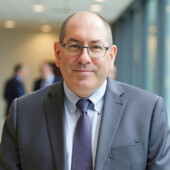00:00:00.000 --> 00:00:06.000
[Speaker: Dr. Tony Vine.]
[Visual: Dr. Vine in his medical office speaking to the camera.]
[Music: Soft, inspirational music begins.]
Hi, I'm Dr. Tony Vine. I'm a laparoscopic
surgeon, so I do minimally invasive surgery,
00:00:06.000 --> 00:00:13.000
[Visual: Illustration of the digestive tract.]
involving the intestinal tract all the way
from the esophagus down to the anus.
00:00:13.000 --> 00:00:22.000
[Visual: Dr. Vine walking through the hallway of his
medical practice and into his office.]
How I came to medicine was really through my father.
I asked him if he wanted me to take over his dental practice.
00:00:22.000 --> 00:00:30.000
[Visual: Photo of Dr. Vine smiling with his elderly father.]
And he said to me, “For the four years that you go to dental school,
you may as well go to medical school and learn the whole thing.”
00:00:30.000 --> 00:00:38.000
[Visual: Photo of Dr. Vine standing wearing blue scrubs.
Then, Dr. Vine speaking to the camera.]
I have been practicing medicine for approximately
30 years.
00:00:38.000 --> 00:00:47.000
[Visual: Photo of Dr. Vine with former classmates
at Vanderbilt Medical School.]
I graduated from Vanderbilt Medical School in 1989, and started
at Mount Sinai for my residency in that same year…
00:00:47.000 --> 00:00:54.000
[Visual: Back to Dr. Vine speaking directly to
the camera]
…and did two years of research in the middle of
my residency at Massachusetts General Hospital.
00:00:54.000 --> 00:01:03.000
[Visual: Mount Sinai graduation photo of
Dr. Vine with classmates and professors.]
Came back to Sinai in 1994 and graduated
as a chief resident from there in 1996…
00:01:03.000 --> 00:01:10.000
[Visual: Photo of Dr. Vine performing surgery in blue scrubs.]
…and immediately started work in July of 1996.
00:01:10.000 --> 00:01:16.000
[Visual: Dr. Vine, smiling and speaking to the
camera, then a photo of Dr. Vine playing violin in green scrubs.]
In my spare time,
whatever little there may be of it,
you can find me practicing my violin.
00:01:16.000 --> 00:01:24.000
[Visual: Video of Dr. Vine at desk.]
[Visual: Then, photos of Dr. Vine with NY State Senators.]
You might find me preparing for a meeting
with a New York State Senator for lobby day.
00:01:24.000 --> 00:01:29.000
[Visual: Photo of Dr. Vine with one of
his chief residents.]
You might find me teaching the
medical students and residents.
00:01:29.000 --> 00:01:34.000
[Visual: Photo of Dr. Vine with a chief resident.]
I think that my humanistic background,
having been an English major in college,
00:01:34.000 --> 00:01:44.000
[Visual: Video of Dr. Vine playing with the orchestra.
Music: Background music fades out.
Sound of Dr. Vine playing the violin begins.]
being a violinist, I feel that I come to medicine
with more of a humanistic, compassionate approach.
00:01:44.000 --> 00:01:49.000
[Visual: Dr. Vine speaking to camera.
Music: Violin music fades out.
Original background music resumes softly.]
I really try and treat my patients as if they were my family members.
00:01:49.000 --> 00:01:54.000
[Visual: Fade to black.
Music fades out.]
Achalasia
Achalasia is an uncommon esophageal disorder that prevents normal swallowing, making it difficult for food and liquids to pass into the stomach. This happens when the muscles of the entire esophagus fail to contract and propel food into the stomach. The muscle at the bottom of the esophagus (lower esophageal sphincter or LES) also may fail to relax properly. Both contractions and an open LES are essential for moving food downward through the esophagus and into the stomach. While we can fix the opening at the bottom of the esophagus laparoscopically, we cannot revive the nerves or muscles of the esophagus, so after surgery the esophagus will empty into the stomach by gravity. We usually perform a partial plication or folding of the stomach over the esophagus where we have worked to help prevent some of the acid reflux that commonly occurs after opening the LES.
Symptoms of Achalasia
- Difficulty swallowing (Dysphagia)
- Regurgitation
- Choking or coughing
- Chest pain
- Heartburn
- Unintentional weight loss
How is Achalasia Diagnosed?
Dr. Vine works closely with his radiology and gastroenterology colleagues who will likely perform the following tests,
- Esophageal Manometry – A test examining muscle movement in the esophagus to see if the lower esophageal sphincter relaxes properly.
- Barium Swallow (Esophagram) – An X-ray test performed while a patient drinks a barium solution, allowing doctors to observe food and liquid passing through the esophagus.
- Endoscopy (EGD – Esophagogastroduodenoscopy) – A procedure under sedation using a thin, flexible tube with a light and camera (endoscope) to examine the esophagus. stomach and intestines .
- Esophageal pH Monitoring – A test measuring acid levels in the esophagus, often used to distinguish achalasia from Gastroesophageal Reflux Disease (GERD).
- CT Scan or MRI – Advanced imaging used to check for abnormalities, like tumors or structural issues in the esophagus.
While the exact cause is unknown, achalasia is believed to be related to nerve damage, autoimmune conditions or genetic factors. If left untreated, it can cause severe weight loss, malnutrition, or aspiration pneumonia from food entering the lungs. There is a very similar disease in South America called Chagas disease that behaves exactly like achalasia and is caused by a parasitic infection, so travel history may be important to diagnose this condition.
Dr. Anthony Vine has performed many successful laparoscopic procedures on patients suffering from achalasia. For more on this minimally invasive procedure, visit Laparoscopic Esophageal Surgery and Heller Myotomy.

